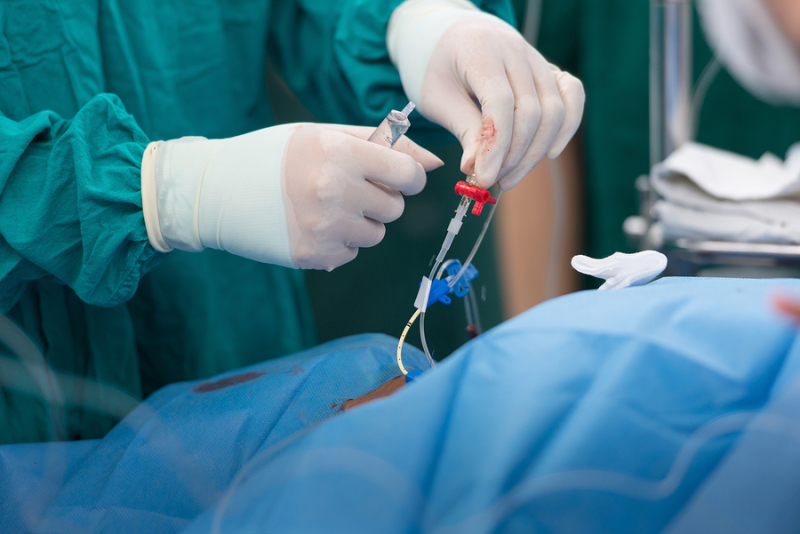
Vascular catheter-related infections are the leading cause of nosocomial bloodstream infections and are associated with significant morbidity in critically ill patients.1-4 These infections are often difficult to diagnose, prevent, and manage, adding tremendously to the cost of health care.
PATHOGENESIS
Catheter-related infections are often difficult to treat because they are caused by organisms often resistant to antimicrobial agents that embed themselves in a biofilm layer on the catheter surface and attach to the thrombin sheath on the surfaces of intravascular devices.
Sources of Infections
The skin and catheter hub are the most common sources of colonization of intra-vascular catheters. For short-term, non-tunneled, noncuffed catheters, the skin insertion site is the major source of colonization, whereby organisms migrate along the external surface of the catheter and the intercutaneous and subcutaneous segments, leading to colonization of the intravascular catheter tip, which may lead to bloodstream infection. For long-term catheters, such as cuffed, tunneled, silicone catheters (Hickman or Broviac), or implantable catheters (such as ports), the lumen of the hub or the bell of the port is the major source of colonization. These sites may become contaminated through the hands of medical personnel during manipulation of the catheter. Be-cause the skin of the patient or the hands of medical personnel are the main sources for the contamination of catheters, staphylococci, particularly coagulase-negative staphylococci, and Staphylococcus aureus are the leading causes of CRBSIs, as shown in a pooled estimate derived from prospective studies published in the 1990s that used quantitative catheter cultures. Most of the gram-negative bacilli causing CRBSIs are nonenteric or-ganisms acquired from the hospital environment, such as Stenotrophomonas maltophilia, Pseudomonas organisms, and Acinetobacter species. Candida albicans and Candida parapsilosis also colonize on the hands of medical personnel and are also associated with glucose-containing infusions and total parenteral nutrition. These fungal organisms are, therefore, emerging as important pathogens associated with CRBSIs. Gram-positive bacilli, such as Corynebacterium (especially jeikeium strains) and Bacillus spe-cies, are rarely introduced from the skin or the hub and may cause cath-eter-related infections.
The Biofilm Factor
Staphylococci, Candida, and some other microbes produce a slimy material rich in exopolysaccharides, resulting in the formation of a micro-bial biofilm. The biofilm helps these organisms adhere to and sur-vive on the surfaces of foreign bod-ies in the bloodstream. The organi-zational structure of the biofilm is the result of communication be-tween microbes using an elaborate system of chemical messengers composed of acyl homoserine–lactones.The microorganisms within the biofilm layer are resistant to the activity of antibiotics. Because the biofilm acts as a resistance fac-tor to antibiotics, it is often diffi-cult to eradicate a catheter-related infection without the removal of the catheter.
The Thrombin Sheath Factor
Following catheter insertion, a thrombin layer or sheath covers the external and the internal surfaces of the intravascular segment. This sheath is rich in host-derived pro-teins, such as fibrin, fibronectin, thrombospondin, and laminin, that act as adhesins. Therefore, the thrombin layer that forms on the intravascular surface of a catheter actually promotes adherence of potential microbial pathogens to that surface. Staphylococcus aureus binds strongly to fibronectin, fibrinogen, laminin, and thrombospondin. In addition, coagulase-negative staphy-lococci bind to fibronectin, while C albicans binds to fibrin.
DIAGNOSIS
The roll-plate semiquantitative culture method is the most commonly used technique for culturing vascular catheters. However, this method is limited in that it cultures only the external surface of catheters and may not retrieve organisms that are well embedded within the biofilm layer on the catheter surface. This tech-nique is of limited usefulness in long-term catheters, in which the inter-nal surface is the predominant source of colonization and blood-stream infection. Several quanti-tative catheter culture methods are useful in establishing the diagnosis of CRBSI, such as the use of vortex, sonication, or flushing the catheter lumen with broth. The soni-cation quantitative method was superior to the semiquantitative catheter culture technique in sev-eral studies and in a recent meta-analysis. The limitation of the semiquantitative and quantitative catheter culture methods is that they require removal of the catheter to aid in the diagnosis of CRBSIs. This of-ten results in wasteful removal of noncolonized catheters. This has led to new techniques for diagnosing CRBSIs without catheter removal.
Novel culture techniques that suggest a catheter infection with-out removal of the catheter include the following.
PREVENTION
New technologies that have been developed to prevent CRBSIs and have been shown in clinical studies to be efficacious in decreasing the risk of CRBSIs:
Silver Ions
Silver in its ionic form has broad-spectrum antimicrobial activity against bacteria and fungi. A silver-impregnated subcutaneous colla-gen cuff has been developed and is usually placed at the interface of the skin insertion site and the proximal subcutaneous space. This cuff significantly decreases the risk of colonization associated with short-term catheters (mean duration of placement, ,10 days). However, the silver cuff failed to pre-vent CRBSIs for long-term cath-eters with a mean duration of placement of 20 days or longer. This could be attributed to the bio-degradable nature of the collagen, whereby the silver ions chelated to the cuff are released completely within 3 to 7 days.
Antimicrobial/Anticoagulant
Flush Solution
Antimicrobial flush solutions, of-ten consisting of an anticoagulant with an antimicrobial agent, have been used to fill the lumen of the catheter at least once daily. This procedure has been mostly used in long-term catheters in which the hub and luminal colonization are the leading causes of CRBSIs. However, this intervention could also be useful in short-term catheters.